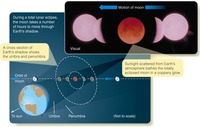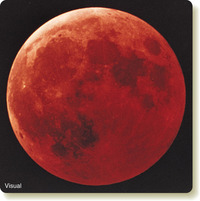|
|
IN CULTURES ALL AROUND THE WORLD, the sky is a symbol of order and power, and the moon is the regular counter of the passing days. So it is not surprising that people are startled and sometimes worried when they see the moon grow dark and angry red. To understand these events, you must begin with Earth’s shadow.
Earth’s ShadowEarth’s shadow consists of two parts. The umbra is the region of total shadow. If you were floating in space in the umbra of Earth’s shadow, you would see no portion of the sun; it would be completely hidden behind Earth. However, if you moved into the penumbra, you would be in partial shadow and would see part of the sun peeking around Earth’s edge. In the penumbra, the sunlight is dimmed but not extinguished.
You can make a model of Earth’s shadow by pressing a map tack into the eraser of a pencil and holding the tack between a lightbulb a few feet away and a white cardboard screen (Figure 3-2). The lightbulb represents the sun, and the map tack represents Earth. If you hold the screen close to the tack, you will see that the umbra is nearly as large as the tack and that the penumbra is only slightly larger. However, if you move the screen away from the tack, the umbra shrinks, and the penumbra expands. Beyond a certain point, the shadow has no dark core at all, indicating that the screen is beyond the end of the umbra.
The umbra of Earth’s shadow is over three times longer than the distance to the moon and points directly away from the sun. A giant screen placed in the shadow at the average distance of the moon would reveal a dark umbral shadow about 2.5 times the diameter of the moon. The faint outer edges of the penumbra would mark a circle about 4.6 times the diameter of the moon. Consequently, when the moon’s orbit carries it through the umbra, it has plenty of room to become completely immersed in shadow.
Total Lunar EclipsesA lunar eclipse occurs when the moon passes through Earth’s shadow and grows dark. If the moon passes through the umbra and no part of the moon remains outside the umbra in the partial sunlight of the penumbra, the eclipse is a total lunar eclipse.
Figure 3-3 illustrates the stages of a total lunar eclipse. As the moon begins to enter the penumbra, it is only slightly dimmed, and a casual observer may not notice anything odd. After an hour, the moon is deeper in the penumbra and dimmer; and, once it begins to enter the umbra, you see a dark bite on the edge of the lunar disk. The moon travels its own diameter in an hour, so it takes about an hour to enter the umbra completely and become totally eclipsed. The period when the moon is completely in shadow is called totality.
Even when the moon is totally eclipsed, it does not disappear completely. Sunlight, bent by Earth’s atmosphere, leaks into the umbra and bathes the moon in a faint glow. Because blue light is scattered more easily than red light, it is red light that penetrates through Earth’s atmosphere to illuminate the moon in a coppery glow (Figure 3-4). If you were on the moon during totality and looked back at Earth, you would not see any part of the sun because it would be entirely hidden behind Earth. However, you would see Earth’s atmosphere illuminated from behind by the sun in a spectacular sunset completely ringing Earth. It is the red glow from this sunset that gives the totally eclipsed moon its reddish color.
How dim the totally eclipsed moon becomes depends on a number of things. If Earth’s atmosphere is especially cloudy in those regions that must bend light into the umbra, the moon will be darker than usual. An unusual amount of dust in Earth’s atmosphere (from volcanic eruptions, for instance) also causes a dark eclipse. Also, total lunar eclipses tend to be darkest when the moon’s orbit carries it through the center of the umbra.
The exact timing of a lunar eclipse depends on where the moon crosses Earth’s shadow. The moon spends about an hour crossing the penumbra, and then another hour entering the darker umbra. Totality can last as long as 1 hour 40 minutes followed by the emergence of the moon into the penumbra plus another hour as it emerges into full sunlight. A total lunar eclipse can take nearly six hours from start to finish.
Partial and Penumbral Lunar EclipsesNot all eclipses of the moon are total. Because the moon’s orbit is inclined by a bit over 5° to the plane of Earth’s orbit, the moon does not always pass through the center of the umbra.
If the moon’s orbit carries the full moon too far north or south of the umbra, the moon may only partially enter the umbra. The resulting partial lunar eclipse is usually not as dramatic as a total lunar eclipse. Because part of the moon remains outside the umbra, it receives some direct sunlight and looks bright in contrast with the dark part of the moon inside the umbra. Unless the moon almost completely enters the umbra, the glare from the illuminated part of the moon drowns out the fainter red glow inside the umbra. Partial lunar eclipses are interesting because part of the full moon is darkened, but they are not as beautiful as a total lunar eclipse.
If the orbit of the moon carries it far enough north or south of the umbra, the moon may pass through only the penumbra and never reach the umbra. Such penumbral eclipses are not dramatic at all. In the partial shadow of the penumbra, the moon is only partially dimmed. Most people glancing at a penumbral eclipse would not notice any difference from a full moon.
Total, partial, or penumbral, lunar eclipses are interesting events in the night sky and are not difficult to observe. When the full moon passes through Earth’s shadow, the eclipse is visible from anywhere on Earth’s dark side. Most full moons cross north or south of Earth’s shadow and there is no eclipse at all, but one or two lunar eclipses occur in most years. Consult Table 3-1 to find the next lunar eclipse visible in your part of the world.
Why doesn’t Earth’s shadow on the moon look red during a partial lunar eclipse?
Here you need to build an argument based on geometry. During a partial lunar eclipse, part of the moon protrudes from Earth’s umbral shadow into sunlight. This part of the moon is very bright compared to the fainter red light inside Earth’s shadow, and the glare of the reflected sunlight makes it difficult to see the red glow. If a partial eclipse is almost total, so that only a small sliver of moon extends out of the shadow into sunlight, you can sometimes detect the red glow in the shadow.
Of course, this red glow does not happen for every planet-moon combination in the universe. Adapt your argument for a new situation. Would a moon orbiting a planet that had no atmosphere glow red during a total eclipse? Why or why not?
Figure 3-2
The shadows cast by a map tack resemble the shadows of Earth and the moon. The umbra is the region of total shadow; the penumbra is the region of partial shadow.
Figure 3-3
During a total lunar eclipse, the moon passes through Earth’s shadows. A multiple-exposure photograph shows the moon passing through the umbra of Earth’s shadow. A longer exposure was used to record the moon while it was totally eclipsed. The moon’s path appears curved in the photo because of photographic effects. (© 1982 Dr. Jack B. Marling)
Figure 3-4
During a total lunar eclipse, the moon turns coppery red. In this photo, the moon is darkest toward the lower right, the direction toward the center of the umbra. The edge of the moon at upper left is brighter because it is near the edge of the umbra. (Celestron International)
Table 3-1
Total and Partial Eclipses of the Moon, 2008 to 2014




